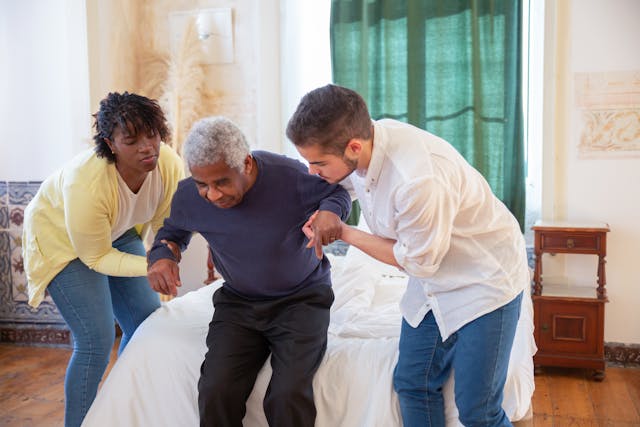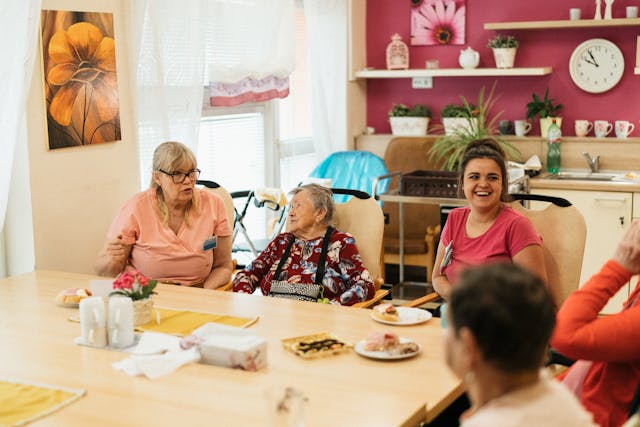The Administration for Community Living reports that 20% of today’s 65-year-olds may need long-term care support. If you need assistance with daily activities to live independently, consider assisted living. Assisted living communities help with mobility, personal care, and other needs, ensuring residents maintain their independence.
Joining an assisted living facility can be a lot to take in. We understand, and we’re here to help. This guide will help you know assisted living costs, requirements, and benefits so you can make an informed decision.
What Is Assisted Living for Seniors?
Assisted living facilities are for seniors who need assistance with activities of daily living (ADLs) but are still independent. Staff at the facilities assist with grooming, bathing, dressing, eating, transportation services, maintaining good hygiene, and housekeeping and laundry.
Residents at assisted living facilities pay monthly rent for a room or apartment and an extra amount for the assisted living care needed. The facilities have shared common areas such as a dining and activity room, and a library.
Assisted living facilities have different offerings. Some only provide basics, while others offer luxury amenities. They have staff on-site around the clock.
Assisted Living Facility vs Nursing Facility
Assisted living communities provide safe, long-term care for active seniors who can no longer live on their own and need help with everyday tasks. These seniors don’t require 24/7 skilled nursing care, and the facilities have an apartment-like appearance.
Nursing facilities (nursing homes), on the other hand, provide skilled residential care for elderly adults with chronic conditions or serious medical issues that require 24-hour supervision. Hospital-level care is provided at these facilities, so they tend to look a little institutional.
5 Levels of Care in Assisted Living
Level 1: Low Level of Care
These residents are mostly independent but may need reminders to perform ADLs. A low level of assistance or supervision may be needed to ensure they perform tasks correctly and safely. The seniors move to a higher level of care as they start to need more help with additional ADLs.
Level 2: Moderate Level of Care
Seniors at this level typically need assistance with at least one activity of daily living, such as bathing or dressing. They may get assistance with more than one ADL. Mixing assistance and independence is common at this level.
Level 3: High Level of Care
Individuals at this level struggle to complete most or all of their ADLs and require assistance from multiple caregivers. Supervision may be required as they complete ADLs, or caregivers must complete ADLs for them.
Additional Levels
Some communities have additional levels based on the care given, how many caregivers are needed, or the number of ADLs a senior needs help with.
Level 4: Advanced Care
Seniors here require extensive assistance and medical attention. Those in this category may suffer from memory-related disorders such as dementia or Alzheimer’s disease or have complex medical needs. They need help moving around and encouragement to participate in social activities.
Level 5: Advanced Care
Residents at this level need help with most tasks, from getting out of bed to toileting. They may start to show signs of Alzheimer’s and have other health concerns. They require close supervision and frequent assessment of their care needs. They also need hands-on support to engage in activities.
Cost of Assisted Living

Each U.S. city and state has a different median for the cost of assisted living, but the national median is approximately $4,774 a month (57,288 a year). This is according to the 2023 Genworth Cost of Care Survey. But the cost is much higher and lower in some states or cities. Seattle and Washington, D.C. facilities charge more, while Miami and St. Louis facilities charge less. The cost also depends on housing. Residents pay different rates for private bedrooms, shared bedrooms, and full apartments.
States with the Most Affordable Assisted Living
These 10 states have the lowest median monthly assisted living costs:
- Wyoming
- Alabama
- Mississippi
- Louisiana
- Georgia
- Utah
- Kentucky
- New Mexico
- Arkansas
- South Carolina
Does Health Insurance Pay for Assisted Living?
A long-term care insurance policy may cover assisted living costs, but most health insurance policies don’t. If you or a spouse qualify as wartime military veterans, the government may send you a monthly monetary benefit you can use to pay for assisted living. The Veterans Administration’s Aid and Attendance program provides the monetary benefits.
Does Medicaid Pay for Assisted Living?
According to the National Council on Aging, Medicaid doesn’t cover the room and board part of assisted living costs. However, many states give waivers to help cover the cost of support services. To get the waiver, apply for Medicaid benefits first by contacting your state’s Medicaid agency.
Does Medicare Pay for Assisted Living?
No, Medicare only covers short-term residential or in-home care for people recovering from a hospital stay. It also covers short-term care in a skilled nursing facility. But it doesn’t cover long-term care costs for assisted living.
Low Income Assisted Living Options

According to U.S. Census Bureau data, 10.3% of Americans aged 65 and older live in poverty. Those who rely on Supplemental Security Income (SSI) get $943 (individuals) and $1,415 (couples). Seniors seeking low-income assisted living can choose from the following options:
Medicaid Waivers
These waivers prevent or delay seniors from moving into nursing homes and cover some long-term care services for older adults, people with dementia, and people with disabilities. The services are provided in different settings, from assisted living facilities to adult day care centers.
United States Department of Housing and Urban Development (HUD) programs
While the HUD gives financing to organizations constructing assisted living facilities, it also provides financial assistance to individuals through its Section 8 program. Older adults who need help paying for assisted living expenses can request financial assistance under the program.
Veterans Benefits
There isn’t a direct VA program that assists veterans in need of senior care, but the Department of Veterans Affairs runs programs that offer some support to veterans seeking senior care. While the offerings may vary from state to state, you can combine different resources to create the best affordable assisted living solution.
Aid and Attendance Program
The Aid and Attendance Program qualifies eligible veterans for additional funds, on top of what they currently receive. The funds help the veteran complete activities of daily living, so you can use the money to pay for assisted living facility costs. But you must meet the following requirements:
- Be a United States veteran
- Require assistance with everyday tasks
- Have certain eyesight limitations
- Be bedridden
- Be in a nursing home due to mental or physical incapacity or disability
The good news is you don’t need to meet all these criteria to be eligible for this program.
Veteran Directed Care Program
The Veteran Directed Care Program gives additional funds to eligible veterans so they can choose and hire their own caregivers—or with the help of their representative.
While the VA doesn’t offer benefits specifically for assisted living,this program covers some of the assisted living care services seniors need. To qualify for the program, you should:
- Be enrolled for VA benefits
- Be eligible for community care
- Meet specific clinical criteria
- Live in a location that offers the program
VA Community Living Center
A VA Community Living Center is like a nursing home, but the facilities are VA-run. Residents are encouraged to decorate their rooms and even bring pets to create a home-like environment. VA facilities are a great option for qualifying veterans looking for short-term or long-term care. But because they are similar to nursing homes, residents have less independence and comfort.
Armed Forces Retirement Home
The Armed Forces Retirement Home is similar to a retirement home. It’s the Federal Government’s initiative that provides eligible veterans with a thriving community. But residents must be able to live independently upon admission. Care options—such as long-term care, memory support, and assisted living—are offered to veterans as they become less independent.
State Veterans Home
State Veterans Homes offer veterans the services they need to live a comfortable and meaningful life—like nursing home care, domiciliary care, and adult daytime care. The homes are run by individual states and not the VA. But the VA performs annual inspections to ensure they meet all standards.
Social Security
How you use your Social Security benefits is completely up to you. You can use the funds to pay for your needs, including assisted living facility costs. But the money you get may not be enough to cover the entire cost.
Some states offer optional state supplements (OSS) and Supplemental Security Income (SSI) payments on top of Social Security, but these don’t cover the entire cost of assisted living. You’ll still need to pay for some expenses yourself. However, the benefits can help make assisted living more affordable.
Assisted Living Requirements
To get in assisted living, you must meet the following requirements:
- Live independently with assistance
- Should not require continuous medical attention and must have some mobility.
While staff at these facilities help with some ADLs, they may not offer constant supervision or medical care.
Who Qualifies for Assisted Living?

Seniors with the Minimum Age
Assisted living facilities accept seniors, but the minimum age requirements depend on the facility. Some facilities accept seniors as young as 55, while others require residents to be at least 65 years old. If you’re old enough for a Golden Buckeye card, you can gain admission into an assisted living facility.
Must Be in Relatively Good Health
To qualify for assisted living, you shouldn’t have medical issues that require skilled nursing and round-the-clock care. You must be in relatively good health and ensure any disease or chronic illness is well managed.
Daily Support Needs
To gain admission into an assisted living facility, you must require support to perform everyday activities such as grooming, dressing, feeding, and walking. Assisted living ensures you get support to maintain some independence as you get the help you need.
Who Doesn’t Qualify for Assisted Living?
- Bedridden individuals
- Seniors with extensive medical issues
- Memory-care patients—those with Alzheimer’s disease or dementia
Seniors needing round-the-clock nursing care or those suffering from memory impairments qualify to join skilled nursing facilities. These residents require constant supervision, as those with memory impairments might leave the facility unknowingly.
Bedridden seniors are also not a good fit for assisted living, they need to be in skilled nursing facilities, as they can’t move or walk around even with assistance.
Assisted Living Requirements Before Admission
- Level of care assessments to determine how much assistance is needed.
- Mental condition assessment to check if you’re experiencing any confusion or dementia.
- Medication management to determine if the resident can manage their medications or if a nurse is needed.
- Sensory assessments for vision and hearing
- ADL assessments to know the activities of daily living the person can do. This may be reassessed every six months.
These assessments will help staff at the assisted living facility to create a care plan for you or your loved one. The plan will detail the person’s dietary needs, medications, dosages, assistance needed, preferences, personal goals, and other factors.
Benefits of Assisted Living for Seniors

Peace of Mind
Assisted living communities provide peace of mind to seniors. They create a sense of community and provide lots of opportunities for socializing and forming friendships. Senior adults can spend time together and build meaningful connections.
Personalized Care
Assisted living facilities give seniors the exact care they need—custom medical care, memory services, activities, and rehabilitation. They provide the most effective and efficient care to residents based on their personal needs.
Access to Healthcare
A licensed assisted living facility offers assistance with ADLs such as housekeeping, laundry, and transportation. Some facilities offer limited medical assistance and recreational and wellness activities.
Social Engagement
An assisted living community combines social engagement, activity, and fun with required support and assistance. Residents have countless opportunities to socialize with new friends, family, and staff. They can even sign up for classes and learn art, baking, and other skills.
Security
Assisted living facilities are safe and secure as they follow strict regulations put in place by the state. They keep residents safe while making it easy for them to receive visitors.
Greater Independence
Assisted living facilities create opportunities for seniors to build unique lifestyles. Seniors are more independent because they have a myriad of activities to choose from, access to a built-in social structure, and a support system for wellness.
Good Nutrition
Assisted living facilities understand the importance of healthy eating and implement strategies to support this. They provide nutritious meals that include fresh fruits and vegetables. They also provide education on the importance of balanced diets.
How to Find the Best Assisted Living Facility
Most assisted living directories get a commission for referrals, so don’t trust them wholeheartedly. Here’s what you can do instead:
- Perform an online search. If you live in Seattle, type “assisted living Seattle” (without the quotes) to see the available facilities and their ratings. Also, take time to read the reviews.
- If you see a facility you like, call and organize a tour. Most assisted living communities offer free tours and are quick to answer questions about costs and amenities.
- When you visit, talk to the residents and their loved ones. Ask them what they like or don’t like about the facility, then consider if the bad outweighs the good. No community is perfect.
- Speak to direct care staff. High employee turnover is never a good sign. As you chat, watch their body language and facial expressions. Then make up your mind.

Alice is a writer and editor for Gainful Retirement. She is passionate about helping retirees live fulfilling lives without financial constraints. She puts a lot of time and effort conducting market research to identify common issues faced by retirees. Her passion is to help you enjoy retirement and solve the most pressing issues you face.
